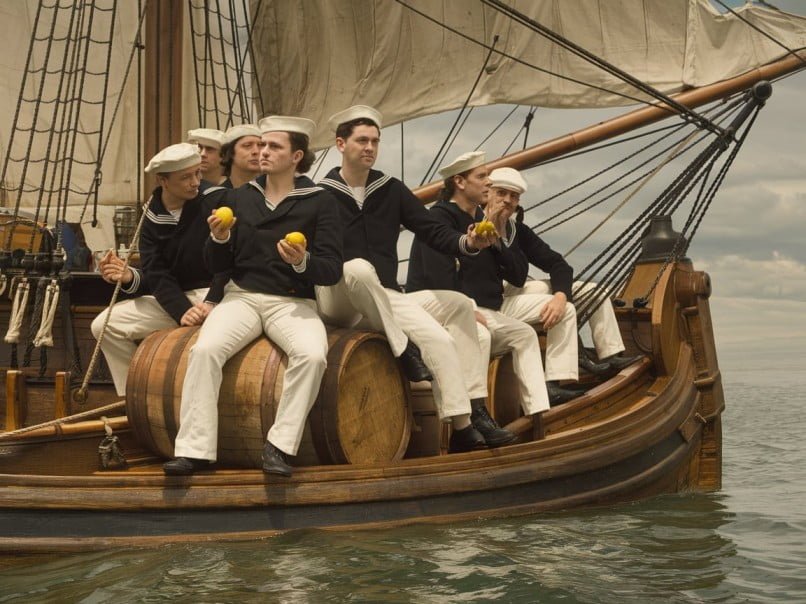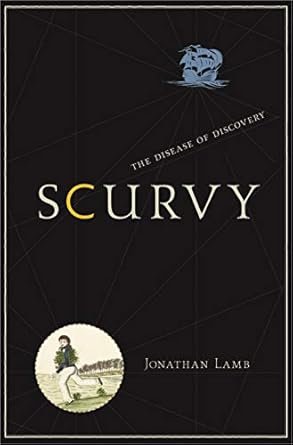Scurvy, the scourge of sailors for centuries, has a fascinating history intertwined with the discovery of its cure. The fruit used to treat scurvy became the subject of numerous books, chronicling the race to understand and conquer this debilitating disease. This blog post delves into the captivating story of scurvy, its treatment, and the books that documented this crucial chapter in medical and maritime history.
Content Table
- Understanding Scurvy: The Sailor's Nightmare
- The Quest for a Cure: Enter the Citrus Fruit
- The Royal Navy's Citrus Revolution
- The Lime's Rise to Fame: Birth of the "Limey"
- Scientific Understanding: Vitamin C and Scurvy
- Notable Books on Scurvy and Its Cure
- The Legacy of the Scurvy Cure in Modern Medicine
- Scurvy in the Modern World: Not Just a Historical Footnote
- The Fruit Used to Treat Scurvy in Popular Culture
- Preserving the Legacy: Museums and Exhibitions
- Conclusion: The Enduring Impact of a Simple Fruit
Understanding Scurvy: The Sailor’s Nightmare
Scurvy, a disease caused by severe vitamin C deficiency, plagued long sea voyages for centuries. Sailors suffered from fatigue, joint pain, and bleeding gums. In severe cases, old wounds reopened, and teeth fell out. The fruit used to treat scurvy wasn’t initially known, leaving countless seamen at the mercy of this cruel affliction.
The Quest for a Cure: Enter the Citrus Fruit
The solution to scurvy lay in a simple fruit – citrus. Lemons and limes, rich in vitamin C, became the fruit used to treat scurvy. However, the road to this discovery was long and fraught with misunderstandings.
James Lind’s Groundbreaking Experiment
In 1747, Scottish physician James Lind conducted one of the first clinical trials in medical history. He tested various treatments on scurvy-afflicted sailors, including citrus fruits. Lind’s experiment showed that the fruit used to treat scurvy was indeed effective. This pivotal moment would later be documented in numerous books on the subject.
Lind’s “Treatise on Scurvy”
In 1753, Lind published his “Treatise on Scurvy,” one of the earliest books to document the fruit used to treat scurvy. This seminal work detailed his experiments and findings, laying the groundwork for future research and treatment protocols.

The Royal Navy’s Citrus Revolution
Despite Lind’s discoveries, it took decades for the British Royal Navy to fully implement citrus as a preventative measure. The fruit used to treat scurvy finally became a standard issue in 1795, dramatically reducing scurvy rates among British sailors.
Captain Cook’s Voyages: A Testament to Citrus
Captain James Cook’s voyages in the late 18th century further proved the efficacy of the fruit used to treat scurvy. Cook’s meticulous records, later published in book form, provided valuable insights into the prevention and treatment of scurvy during long sea voyages.
The Lime’s Rise to Fame: Birth of the “Limey”
The British Navy’s adoption of limes as the fruit used to treat scurvy led to the nickname “Limey” for British sailors. This term, initially pejorative, became a point of pride, symbolizing the Navy’s superior health and readiness.
Scientific Understanding: Vitamin C and Scurvy
It wasn’t until the early 20th century that scientists fully understood why citrus was the fruit used to treat scurvy. The discovery of vitamins, particularly vitamin C (ascorbic acid), provided the scientific explanation for scurvy and its cure.
Szent-Györgyi and Vitamin C
In 1937, Albert Szent-Györgyi won the Nobel Prize for his work on vitamin C, including its role in preventing scurvy. His research added a new chapter to the books on the fruit used to treat scurvy, providing a molecular understanding of the disease and its cure.
Notable Books on Scurvy and Its Cure
Throughout history, numerous books have been written about scurvy and the fruit used to treat it. These works provide valuable insights into the medical, historical, and social aspects of this disease and its treatment.
“Scurvy: How a Surgeon, a Mariner, and a Gentleman Solved the Greatest Medical Mystery of the Age of Sail” by Stephen Bown

This book offers a comprehensive look at the history of scurvy and the discovery of its cure. Bown’s work is a testament to the importance of the fruit used to treat scurvy in maritime history.
“Lime, Lemon, and Sarsaparilla: The Italian Community in South Wales, 1881-1945” by Colin Hughes

While not exclusively about scurvy, this book touches on the cultural impact of citrus fruits, including their role as the fruit used to treat scurvy. It provides an interesting perspective on how medical discoveries can influence cultural dynamics.
“Scurvy: The Disease of Discovery” by Jonathan Lamb

Lamb’s book explores the psychological and cultural impacts of scurvy, going beyond just the medical aspects. It offers a unique perspective on how the fruit used to treat scurvy changed not just health outcomes, but also the human experience of long-distance sea travel.
The Legacy of the Scurvy Cure in Modern Medicine
The discovery of the fruit used to treat scurvy had far-reaching implications beyond maritime health. It laid the groundwork for our understanding of nutrition’s role in health and disease prevention.
Nutritional Science Advancements
The scurvy story sparked increased interest in nutritional science. Researchers began exploring how other vitamins and nutrients impact health, leading to numerous books on the subject. The fruit used to treat scurvy became a symbol of how simple dietary changes could have profound health effects.
Lessons for Modern Clinical Trials
James Lind’s scurvy experiments are often cited in books about clinical trial methodology. The story of the fruit used to treat scurvy serves as an early example of evidence-based medicine, influencing how we conduct medical research today.
Scurvy in the Modern World: Not Just a Historical Footnote
While often considered a disease of the past, scurvy still occurs in the modern world. Recent books on nutrition and public health often reference the fruit used to treat scurvy when discussing vitamin C deficiency in vulnerable populations.
Scurvy in Developed Nations
Surprisingly, cases of scurvy have been reported in developed countries, often among individuals with restricted diets. These incidents have sparked renewed interest in books about the fruit used to treat scurvy, as medical professionals seek to educate the public about the importance of vitamin C.
Global Health Initiatives
International health organizations continue to promote citrus and other vitamin C-rich foods in regions where malnutrition is common. Their educational materials often reference historical books about the fruit used to treat scurvy to illustrate the importance of a balanced diet.
The Fruit Used to Treat Scurvy in Popular Culture
The story of scurvy and its cure has captured the public imagination, appearing in various forms of media beyond academic books.
Historical Fiction
Numerous historical novels set in the Age of Sail feature scurvy as a plot point. These books often dramatically portray the discovery of the fruit used to treat scurvy, bringing this important medical breakthrough to life for modern readers.
Maritime Adventure Books
Adventure books set on the high seas frequently mention the fruit used to treat scurvy. Authors use this historical detail to add authenticity to their stories and educate readers about maritime history.

Preserving the Legacy: Museums and Exhibitions
Several maritime museums around the world feature exhibits on scurvy and its treatment. These exhibitions often showcase books and documents about the fruit used to treat scurvy, preserving this important chapter of history for future generations.
The National Maritime Museum, Greenwich
This renowned museum in London has a permanent exhibition on naval medicine, including displays about scurvy and the citrus fruit used to treat it. Visitors can see original copies of books documenting the discovery and implementation of the scurvy cure.
Conclusion: The Enduring Impact of a Simple Fruit
The story of the fruit used to treat scurvy is more than just a tale of medical discovery. It’s a testament to human perseverance, scientific inquiry, and the sometimes simple solutions to complex problems. From Lind’s groundbreaking experiments to modern nutritional science, the humble citrus fruit has played a crucial role in shaping our understanding of health and disease.
As we’ve explored in this post, numerous books have been written about the fruit used to treat scurvy, each offering unique perspectives on this fascinating chapter of history. These works not only document the past but continue to inform and inspire readers today, reminding us of the importance of nutrition and the potential for simple solutions to have profound impacts.
Whether you’re a history buff, a medical professional, or simply curious about the stories that have shaped our world, the books about the fruit used to treat scurvy offer a wealth of knowledge and inspiration. They stand as a testament to human ingenuity and the ongoing quest for understanding that drives scientific progress.
So, the next time you enjoy a citrus fruit, remember its illustrious history. It’s not just a tasty snack or a source of vitamin C – it’s a piece of medical history, a cure that saved countless lives, and the subject of books that continue to educate and fascinate readers around the world.





